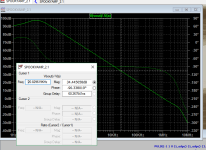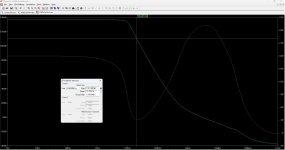Seen that. Wolverine @ 20K has 70db total , about 38 "extra" for correction. This is with TMC. Some 3 stage hitachi IPS's can muster (90 gain)one hope is for the depth of negative feedback - at least 90 dB deep at a frequency of 20 kHz - I think this is a separate class of amplifiers as “ultra deep NFB”
extra at 20Khz. IPS's such as these , you need "fancy" (lead /lag) compensation to keep phase margin.
TMC also trades margin for extra 20K gain.
Some designs (symmetrical - leach) are just more linear natively (below 2) , can still get <20PPM 20Khz with simple miller and only 30'ish NFB. Margin (90 deg.) stays
large out to many Mhz. I've omitted any comp. on these types and they still won't oscillate (or they just "rang" on a square wave). Still , a small miller
to define the unity point is good practice. The miller does not slow down even a CFA (much).
Attachments
Last edited:
NFB loop does not see the decoupled Vbe. It's Gain is way subsonic.any, even small, gain of a nonlinear element inside the NFB loop requires frequency correction.
This is the quality level of Hi-Fi from the 70s of the last century)))Wolverine @ 20K has 70db total , about 38 "extra" for correction.
just not as “fancy” as Leach, just a progressive correction.Some 3 stage hitachi IPS's can muster (90 gain)
extra at 20Khz. IPS's such as these , you need "fancy" (lead /lag) compensation to keep phase margin.
TMC also trades margin for extra 20K gain.
The input stage of a symmetrical Leach has a gain at a frequency of 1 kHz as much as -4 dB (nonsense), and the nonlinearity of this open loop stage is +/- 10 dB. the depth of the NFB at a frequency of 20 kHz is only 16 dB. and there is completely no neutralization of the internal resistance of the VAS multiplier.Some designs (symmetrical - leach) are just more linear natively (below 2)
What is there to comment on?
This is not enough for "ultra-deep NFB" , a minimum of 110 dB is needed.With a 3 pole TMC/TPC I can do 85dB loop gain at 20kHz.
You are in English audio forum and progresive correction means nothig here.just not as “fancy” as Leach, just a progressive correction.
Better read Cordell and Self audio books to learn about audio and the types of compensation (not correction).
There are different compesation types as TPC (Two Pole Compesation) TMC (Transitional Miller Compensation) and off course ordinary Miller compensation.
Cherry suggested that compensation capacitor could be connected to the amp output.
Here you can see samething new here, OITPC: https://www.diyaudio.com/community/threads/oitpc-output-inclusive-tpc-not-tmc.317335/
Damir
These are different and non-overlapping concepts.How strong NFB has H-ENG if it is known?
It's like asking how many squares there are in the shape of a circle...)))
106dB@1kLKA: How strong NFB has H-ENG if it is known?
100dB@10k
80dB@20k
(H-ENG, Homeless-ENGineer is the name of my amplifier)
Don’t mislead the forum, you seem to be doing this on purpose because you don’t understand the essence of progressive correction (compensation for you).You are in English audio forum and progresive correction means nothig here.
ok, these are good books, but they didn't write about dynamic frequency filtering using the state variable method, which can be used to correct amplifiers.Better read Cordell and Self audio books
for your version, ok, but not for progression, because Cherry an increase in the filtering order in the feedback circuit is used, so you either do not see or do not understand the essence of progressive correction. (or compensation if that's how you like it).Cherry suggested that compensation capacitor could be connected to the amp output.
all you need is +/-3dB linearity in the openloop audio frequency band, compensation outside the feedback loop and ultra-deep NFB, and you will have a real high-end.106dB@1k
100dB@10k
80dB@20k
I think this topic is a long way from the OP amplifier suggestion.
Isn't it?
Isn't it?
That was a quite long thread to read and there are some real measurement not only LTspice simulation.
Here is ClassA 100W amp: https://www.diyaudio.com/community/threads/100w-cfa-class-h-classa-classb.394923/#post-7545142
Here is ClassA 100W amp: https://www.diyaudio.com/community/threads/100w-cfa-class-h-classa-classb.394923/#post-7545142
Yeah, I think he was looking for a lot simpler build, that he could understand, around parts he could get.I think this topic is a long way from the OP amplifier suggestion.
Isn't it?
There are always ways of doing things better, if throwing infinite resources at the project.
Could you explain that progressive compensation (or correction if you like more), as in those books I mentioned before there is nothing with this name?for your version, ok, but not for progression, because Cherry an increase in the filtering order in the feedback circuit is used, so you either do not see or do not understand the essence of progressive correction. (or compensation if that's how you like it).
You already call it “progressive compensation” - that means you are making progress.Could you explain that progressive compensation (or correction if you like more)
Much of the methodology has already been indirectly described above. It may not seem obvious to you for application, but high-order compensation in the general negative feedback circuit does not seem obvious to me, especially for an amplifier in class AB.
And your next question is where amplifiers with such a technique are - these are not my developments and it’s not for me to share them on the forum, but ready-made simple amplifier blocks are quite suitable as an option for finalizing the finished product. Not every amplifier topology is suitable for progressive compensation; here on the forum I saw only one such option for radio amateurs, interesting, because he works for a company that produces amplifiers for concerts.
here on the forum there are ready-made solutions for repetition; many have been setting up modes for years to get a high-quality amplifier.the Author of this thread wants scheme+pcb+guide of 100W amplifier or he wants to create his own design or amp based on some design...
Judging by the author’s posts, it will take him at least 5 years to create something of his own.
It is best to use a ready-made solution, and even better when the author of the finished amplifier is here on the forum and can suggest the nuances.
Why you talk about “progressive compensation” if you can't explain it here, this is DIY forum and poeple like to built.You already call it “progressive compensation” - that means you are making progress.
Much of the methodology has already been indirectly described above. It may not seem obvious to you for application, but high-order compensation in the general negative feedback circuit does not seem obvious to me, especially for an amplifier in class AB.
And your next question is where amplifiers with such a technique are - these are not my developments and it’s not for me to share them on the forum, but ready-made simple amplifier blocks are quite suitable as an option for finalizing the finished product. Not every amplifier topology is suitable for progressive compensation; here on the forum I saw only one such option for radio amateurs, interesting, because he works for a company that produces amplifiers for concerts.
- Home
- Amplifiers
- Solid State
- High quality class AB 100 watt amp


